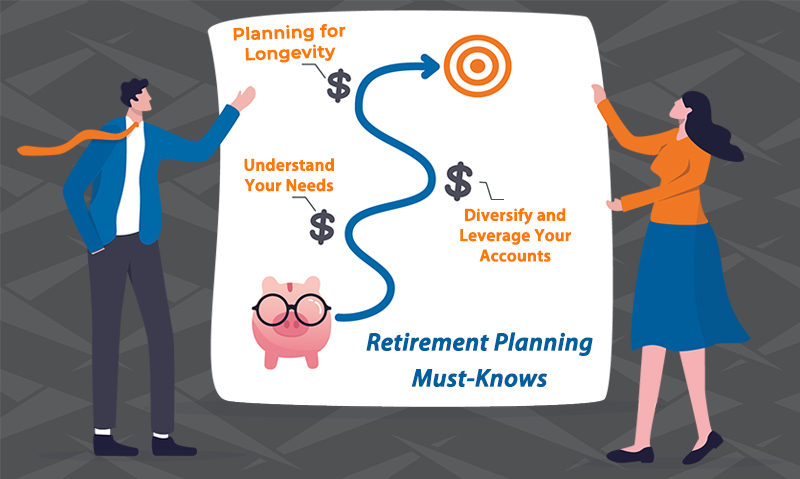
Retirement Planning Must-Knows
Retirement planning is one of the most important financial journeys you’ll ever take. It requires consideration, strategic decision-making and a long-term perspective. Whether you’re in your 20s or your 50s, it’s never too early, or too late, to take steps toward securing your financial future. Here are the must-knows to guide you on your retirement planning journey.
1. Start Early, Start Smart
The sooner you start saving for retirement, the better. Time is your greatest ally when retirement planning because of compound interest. Even small contributions made early can grow significantly over decades. For example, investing $100 per month at an average annual return of 7% from age 25 to 65 can result in over $250,000. If you wait to start planning, you’ll need to contribute even more to see the same results.
2. Understand Your Retirement Needs
How much money will you need in retirement? While individual needs vary, many financial experts recommend saving enough to replace 70% to 80% of your pre-retirement income annually. Consider factors like housing, healthcare, travel, and hobbies. Don’t forget inflation—it erodes purchasing power over time, so plan for rising costs.
3. Leverage Retirement Accounts
Maximizing contributions to tax-advantaged retirement accounts is essential. Options like 401(k) plans and IRAs (Individual Retirement Accounts) allow your money to grow tax-deferred or tax-free, depending on the type of account. If your employer offers a 401(k) match, contribute enough to capture the full match—it’s essentially free money and will benefit your retirement planning.
For those nearing retirement age, catch-up contributions can help you save more. Individuals 50 and older can contribute additional funds to their retirement accounts each year.
4. Diversify Your Investments
A well-diversified portfolio is key to balancing risk and reward. Your asset allocation—how you divide your money among stocks, bonds and other investments—should reflect your risk tolerance, time horizon, and retirement goals. Younger investors may focus on growth-oriented assets like stocks, while those closer to retirement might shift to more conservative investments. Regularly rebalancing your portfolio helps maintain the right mix for retirement planning.
5. Don’t Overlook Healthcare Costs
Healthcare can be one of the most significant expenses to consider when retirement planning. Medicare typically doesn’t cover everything, so consider supplemental insurance or a Health Savings Account (HSA) if eligible. HSAs offer triple tax benefits: contributions are tax-deductible, growth is tax-free, and withdrawals for qualified medical expenses are tax-free.
6. Plan for Longevity
People are living longer, which means your retirement savings may need to last 20, 30, or even 40 years. To avoid outliving your money, develop a withdrawal strategy, such as the 4% rule, which suggests withdrawing 4% of your retirement savings annually, adjusted for inflation.
7. Eliminate Debt Before Retirement
Carrying high-interest debt into retirement can strain your savings. Focus on paying off credit cards, loans, and even your mortgage, if possible, before retiring. This reduces your monthly expenses and gives you greater financial flexibility.
8. Consult a Financial Advisor
Retirement planning can be complex, so don’t hesitate to seek professional guidance. A financial advisor can help you set realistic goals, optimize your savings strategy, and navigate changing market conditions.
Retirement planning is not a one-size-fits-all process. By starting early, leveraging tax-advantaged accounts, and keeping an eye on healthcare costs, you can build a retirement strategy tailored to your needs. Take control of your future today to enjoy a comfortable, secure retirement tomorrow.

